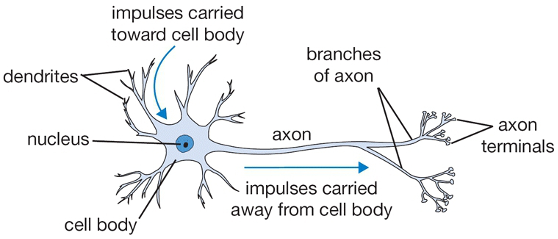Aging carries with it a gradual decline of mental and physical functions. For most people, we can’t run as fast, jump as high, lift as much, or remember things as easily as when we were younger. Even healthy older adults in good physical condition experience a decline in physical performance, strength, reaction time, and balance. These age-related changes are a normal part of aging and usually do not interfere with the ability to live independently.
3.1 Normal Brain Changes with Age
An aging brain experiences many changes. Certain parts of the brain shrink a little although there is not a significant loss of nerve calls, as occurs in Alzheimer’s disease. Shrinkage typically is found in the prefrontal cortex and the hippocampus, areas of the brain important to learning, memory, planning, and other complex mental activities.
In certain brain regions, white matter (myelin-covered axons) is degraded or lost. This affects the brain’s ability to send and receive nerve impulses and to interact with neurons in other parts of the brain. Because white matter connects the different regions of the brain, even a little loss or breakdown of myelin can affect cognition.

An illustration of a healthy neuron showing the nucleus, cell body, dendrites, and axons. The axon is covered with a myelin sheath, similar to the insulation on an extension cord.
Source: WPClipArt.com. Used with permission. From http://www.wpclipart.com/medical/anatomy/cells/neuron/neuron.png.html.
Blood flow to the brain can be reduced as we age because arteries narrow and there is less growth of new capillaries. Due to these normal changes, some healthy older adults may notice a modest decline in their ability to learn new things and retrieve information.
Older adults may not perform as well on complex tasks of attention, learning, and memory compared to younger people. However, if given enough time to perform the task, the scores of healthy people in their 70s and 80s are often similar to those of young adults. In fact, as we age, adults often improve in other cognitive areas, such as vocabulary and other forms of verbal knowledge (NIA, 2023, April 5).
3.2 Differentiating Normal Aging and Dementia
Many people, including healthcare providers, do not understand the difference between normal, age-related changes and dementia—especially when cognitive changes are small. Someone with age-related changes can easily do all activities of daily living—they can prepare their own meals, drive safely, go shopping, and use a computer. They understand when they are in danger and have good judgment. Even though they might not think or move as fast as when they were young, their thinking is normal—they do not have dementia.
Dementia, by contrast cause a progressive impairment of memory, emotional control, judgement, and other cognitive functions. For a person with dementia, these changes eventually become severe enough to affect their ability to live independently.
3.3 Mild Cognitive Impairment
Mild Cognitive Impairment (MCI) is a stage of cognitive function between the expected decline seen in healthy aging and that seen in dementia. Individuals with MCI have a more pronounced cognitive impairment than what would be expected for their age and education, but do not meet functional criteria for dementia (Moreira et al., 2019).
Mild cognitive impairment can be accompanied by changes in behavior and personality. There are no tests for mild cognitive impairment; differentiating normal aging and mild cognitive impairment relies on screening, assessment, and client history.
Although mild cognitive impairment has been described as a transitional stage between normal cognitive aging and dementia, particularly Alzheimer's disease, individuals diagnosed with this disorder do not always progress to Alzheimer's disease and may even revert to normal.
3.4 Cognitive Reserve and Cognitive Health
Cognitive reserve is a concept that suggests that individuals differ in their degree of resilience against age-related brain changes. It means the brain is able to operate effectively even when some of its function is disrupted. It also refers to the amount of damage that the brain can sustain before changes are evident.
People vary in cognitive reserve because of differences in genetics, education, nutrition, occupation, lifestyle, leisure activities, or other life experiences. For one individual, depending on these factors, the balance may tip in favor of a disease process that will ultimately lead to dementia. For another person, with a different reserve and a different mix of genetics, environment, and life experiences, the balance may result in no apparent decline in cognitive function with age.
There is evidence that reserve can be built up through a combination of life experiences, physical exercise, education, occupation, and participation in social and cognitively stimulating activities. These experiences may create a buffer against cognitive decline by enhancing neural connectivity and cognitive ability. This might protect an individual against the effects of disease pathology, compensate for damage, and recruit alternative neural pathways when required (Evans et al., 2018).
